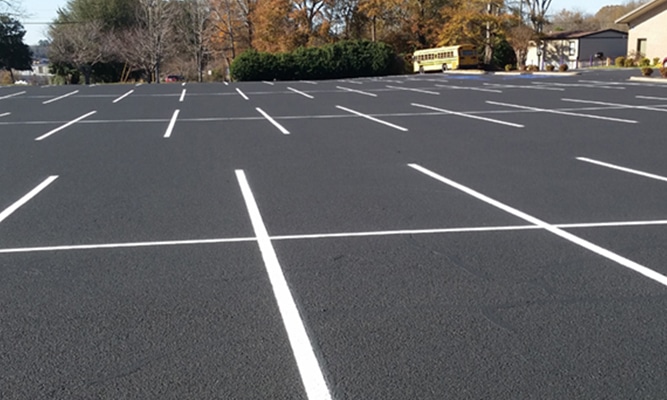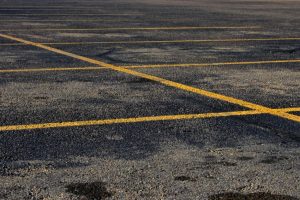A Lot Sealcoating
Parking Lot Seal Coating
- Sealcoat provides an extra protective layer on your asphalt paving, protecting it from water penetration, oil and chemical spills, and oxidation. With this protection, your parking lot is safe from cracking, pothole formation, and depressions. Sealcoating also eliminates the risk of UV rays, which make the surface brittle and inflexible.
- Before Sealcoating After Sealcoating. Sealcoatings is a true 'Barrier coat' between asphalt surfaces and the destructive elements. The term 'sealcoating' means keeping the redeeming properties of asphalt sealed in to prolong the pavement life and preserve its functional properties.
Protective coating for your existing asphalt
Parking Lot Sealing Costs & Prices Sealcoating is an important part of maintaining any parking lot. The average cost to sealcoat a parking lot ranges from $0.20 to $0.30 per square foot. The sealer helps to protect the asphalt surface from sun or water damage. It can also dramatically improve the curb appeal of your business.
There are many benefits to seal coating - it enhances the appearance of old and new asphalt, protects against the elements, and extends the life of your asphalt pavement.
Seal coat is a composition of refined petroleum asphalt emulsion, fillers and fibers. This cold-applied resurfacing and sealing material is ideally suited for parking lots, driveways, playgrounds, tennis courts, or other similar asphalt pavement surfaces.
One of our commonly used products is Steelguard 60 from Raynguard
What is SealCoating
Our typical seal coat job starts out with a standard surface preparation by use of a high powered blower and wire broom sweep as needed to remove any dirt, moss and debris from the surface. The seal coat material is then applied via spray application or wide squeegee depending on existing asphalt surface. Existing rough surfaces will receive a squeegee application to allow for maximum material while creating a smoother surface. Existing smoother surfaces will receive a spray application in order to achieve a heavy coat. The spray application is left untouched to allow for a thicker coat on smoother surfaces. It is important to be able to provide both application processes because the use of a squeegee on a smooth surface tends to leave very little material behind. Once the areas have been properly seal coated and dried, we will apply the striping and open it back up to traffic. Your lot is now ready to be enjoyed and appreciated by all.

It is important to know that while seal coating has many benefits, it's not a substitute for crack fill. Even though it will fill most small cracks and help protect your parking lot from future cracks, it is important to fill large cracks with either a hot crack fill mix. Visit our crack fill section for more info.
Sealcoating is one of the most important elements of a pavement management plan. A sealcoat consists of either coal tar pitch or asphalt cement mixed with inert fillers, water, emulsifying agents, or additives. Applied in thin coats, pavement sealing is used to protect off-highway pavement surfaces against gasoline, oil, salt, water, and ultraviolet rays.
Purpose of Sealcoating

Over time, the surface of asphalt pavement oxidizes and becomes gray or faded in appearance. Seal coating provides a vibrant black finish that protects and prolongs the life expectancy of your parking lot.
How Often Should I Sealcoat My Parking Lot?
We’re frequently asked “How often should I sealcoat my parking lot”? Our recommendation is every 24-36 months. Weather can play a role in how often you should sealcoat, in addition to the traffic on the lot. If your lot is showing signs of cracking, wear and tear and fading, it is a good idea to have your parking lot assessed by a paving professional.
Benefits of Sealcoating
- Beautification
When covered with a dark black sealant, pavement looks and wears like new. Parking lot sealcoating helps to project a positive image of the company, facility, or residential complex. - Slower Oxidation
Sealcoating fills surface voids, which reduces exposure to oxygen and UV rays and reduces the depth to which oil or gas can penetrate the pavement. - Slower Water penetration
Sealcoating acts as a waterproofing agent, minimizing the rate at which water enters pavement. Without it, water can permeate more freely resulting in freeze/thaw expansion and contraction of the pavement. - Resistance to Oil and Gas Spills
Gasoline dripping from a topped-off fuel tank during hot weather can soften and break down unsealed asphalt pavements. Coal tars used in sealcoat are impervious to gas and oil spills. - Easier to Clean and Maintain
Sealcoats fill surface voids while coating the pavement surface. The resulting smooth and even texture makes the surface easier to maintain year-round. For example, snow is easier to remove from a smooth surface, and sweeping is far more effective on a smooth surface. - Increases Pavement Pliability
Sealcoat brings a dark black color to the pavement. The blacker it is, the more heat a pavement draws from the sun. And, the hotter it gets, the more pliable it becomes, which helps it to withstand traffic without cracking. - Protects Asphalt from Pressure Washing
Restaurant parking lots often extend to areas near dumpsters, where food-processing machines are pressure washed. Food waste near the dumpsters may also need to be washed away if it can’t be swept away. Sealcoating protects asphalt cement from the high-volume water pressure and detergents used in pressure washing. - Cost Effective
The price of asphalt will always be affected by crude oil prices, which fluctuate when supplies vary. Sealcoating preserves asphalt for pennies per square foot.
Sealcoating Preparation

Prior to pavement sealing, any structural failures or repairs must be completed. It is advisable to wait a minimum of 12 to 18 months after such repairs before seal coating. Once the parking lot is ready, we will completely clean the asphalt pavement with a sweeper truck and/or mechanical blowers and brooms to remove dirt and debris.
Proper Sealcoating Application
Sealer is a water-soluble product and until the drying process is complete, it is vulnerable. Sealer should be applied during clear conditions and only at the appropriate temperature. Although seal coating is a rather quick application, the drying and cooling time is up to 36 hours.
Advanced Sealcoating Formula
There are two major types of seal coating material used in the United States: coal-tar emulsion sealer and asphalt-based emulsion seal. A hydraulic-driven tanker truck with a sand hog pump system will be used to mix the commercial grade product. We will add approximately 2-4 pounds of sand per gallon of emulsion to increase the solids content while also minimizing the liability against slips and falls. Each parking lot has different conditions; therefore, a mix will be custom designed per each application. On average, 50-60 square feet of asphalt will be covered per gallon of emulsion.

A Lot Sealcoating
An acrylic-based hardening additive or a polymer-modified material may be included in this formula for additional strength and longevity.
We will apply the sealcoating formula using either a squeegee, spray, or a combination of both, depending on the conditions of the lot.
Post Sealcoating Application
Traffic should be kept off a newly sealed surface for a minimum of 24-36 hours to allow for drying and curing time. If this time frame is not practical, sealcoating can be performed in separate mobilizations and or in off-peak hours to maximize convenience.
It is also important to refrain from using sprinklers near the area, hosing down, or washing the area for 48 hours before and after work is completed.